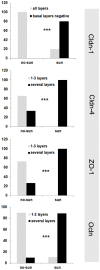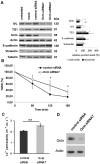Occludin is involved in adhesion, apoptosis, differentiation and Ca2+-homeostasis of human keratinocytes: implications for tumorigenesis
- PMID: 23390516
- PMCID: PMC3563667
- DOI: 10.1371/journal.pone.0055116
Occludin is involved in adhesion, apoptosis, differentiation and Ca2+-homeostasis of human keratinocytes: implications for tumorigenesis
Abstract
Tight junction (TJ) proteins are involved in a number of cellular functions, including paracellular barrier formation, cell polarization, differentiation, and proliferation. Altered expression of TJ proteins was reported in various epithelial tumors. Here, we used tissue samples of human cutaneous squamous cell carcinoma (SCC), its precursor tumors, as well as sun-exposed and non-sun-exposed skin as a model system to investigate TJ protein alteration at various stages of tumorigenesis. We identified that a broader localization of zonula occludens protein (ZO)-1 and claudin-4 (Cldn-4) as well as downregulation of Cldn-1 in deeper epidermal layers is a frequent event in all the tumor entities as well as in sun-exposed skin, suggesting that these changes result from chronic UV irradiation. In contrast, SCC could be distinguished from the precursor tumors and sun-exposed skin by a frequent complete loss of occludin (Ocln). To elucidate the impact of down-regulation of Ocln, we performed Ocln siRNA experiments in human keratinocytes and uncovered that Ocln downregulation results in decreased epithelial cell-cell adhesion and reduced susceptibility to apoptosis induction by UVB or TNF-related apoptosis-inducing ligand (TRAIL), cellular characteristics for tumorigenesis. Furthermore, an influence on epidermal differentiation was observed, while there was no change of E-cadherin and vimentin, markers for epithelial-mesenchymal transition. Ocln knock-down altered Ca(2+)-homeostasis which may contribute to alterations of cell-cell adhesion and differentiation. As downregulation of Ocln is also seen in SCC derived from other tissues, as well as in other carcinomas, we suggest this as a common principle in tumor pathogenesis, which may be used as a target for therapeutic intervention.
Conflict of interest statement
Figures






References
-
- Aijaz S, Balda MS, Matter K (2006) Tight junctions: molecular architecture and function. Int Rev Cytol 248: 261–298. - PubMed
-
- Balda MS, Matter K (2009) Tight junctions and the regulation of gene expression. Biochim Biophys Acta 1788: 761–767. - PubMed
-
- Ebnet K, Suzuki A, Ohno S, Vestweber D (2004) Junctional adhesion molecules (JAMs): more molecules with dual functions? J Cell Sci 117: 19–29. - PubMed
-
- Furuse M, Tsukita S (2006) Claudins in occluding junctions of humans and flies. Trends Cell Biol 16: 181–188. - PubMed
Publication types
MeSH terms
Substances
LinkOut - more resources
Full Text Sources
Other Literature Sources
Medical
Research Materials
Miscellaneous

